In the dimly lit Jack Dempsey dinner hall of the 1906 Mizpah Hotel in Tonopah, Nev., a group of miners, financiers, analysts and the media recently convened to explore the redevelopment of the district’s remaining mineral potential, marking the first meeting of its kind here in over a century.
The group had gathered to delve into the underlying and surrounding rocks of the town, which played a pivotal role in the rise and fall of this desert hamlet’s mining development history.
Nevada’s biggest silver deposits were discovered well over a century ago: the Comstock Lode, discovered around 1860 and then the Tonopah District discovery of the 1900s.
“Nevada became a state as a result of the Comstock – the silver paid for the Civil War and the winning of the Union,” said Bill Howard, executive chairman of Blackrock Silver (TSXV: BRC) during a June site visit. “It’s often said that if Comstock made Nevada, the Tonopah silver deposits were what paid for keeping Nevada a state. That’s why we’re called the ‘Silver State.’”
Nestled in the heart of Nevada, the Tonopah region holds a rich historical mining legacy and an equally promising future.
Below the town, underneath its historical buildings in the surrounding Esmerelda and Nye counties, remain rich gold and silver deposits which again make sense to explore given the use of new technology and higher metals prices. And there’s a newcomer to the party – high-grade lithium clays abound towards the north, west and south of Tonopah, which have sent local prospectors into a spin with the potential EV windfall.
However, for the time being, the historical Tonopah silver deposits are receiving the brunt of exploration investment, with Blackrock Silver and Suma Silver (TSXV: SSVR; US-OTC: SSVRF) looking to breathe new life into the old silver deposits that gave life to the mining town.
Past boom times
Today, the geological setting of the Ancestral Cascades and their richly mineralized high and low-sulphidation systems form the backdrop to the stage for the town’s (population 2,200) economic reinvigoration. The relentless subduction and volcanic activity formed rich mineral deposits that are now drawing prospectors and fortune-seekers back to Nevada.

A half-ounce fine silver coin depicting the story of how Jim Butler and his donkey discovered the rich Tonopah silver district. Credit: Tonopah Trading Company
One time-worn story holds that prospector Jim Butler, a man driven by curiosity and a touch of luck, stumbled upon the treasure that would define Tonopah’s future. It is said his donkey was stubborn, and when the frustrated man picked up a rock to throw at the animal, he found it was quite heavy, signalling the presence of silver.
Sharing his discovery with assay labs, he faced initial disbelief, but his persistence paid off when significant silver deposits were later confirmed. Spurred by his wife’s encouragement, Butler staked the land and named the town Tonopah along with his partners.
Tonopah quickly became a bustling mining town, boasting a peak population by the 1920s of more than 25,000, attracting many miners hoping to strike it rich. The town today still celebrates its annual ‘Butler Days’. Leasing their claims to others in exchange for a share of the revenue, Butler and his partners enjoyed considerable success.
Capital poured into the region, consolidating mining operations and the birth of successful companies such as the West End Mining Company and the Jim Butler Mining Company.
Modern explorations have built upon the knowledge and insights gained from the past. According to Howald, extensive mapping and geological studies, including those conducted by the United States Geological Survey, have revealed two calderas separated by millions of years. The northern caldera, rich in silver, and the southern caldera, focused on gold, have provided a roadmap for mining efforts.
Tonopah’s modern promise
In 2020, a new chapter opened for the Tonopah district, with Blackrock spearheading a deal involving Ely Gold Royalties to consolidate mining rights and resources.
To date, the Blackrock team has consolidated patented claims, with the Tonopah West project representing the western extension of the famed Tonopah silver lode with control over more than half of the overall district.
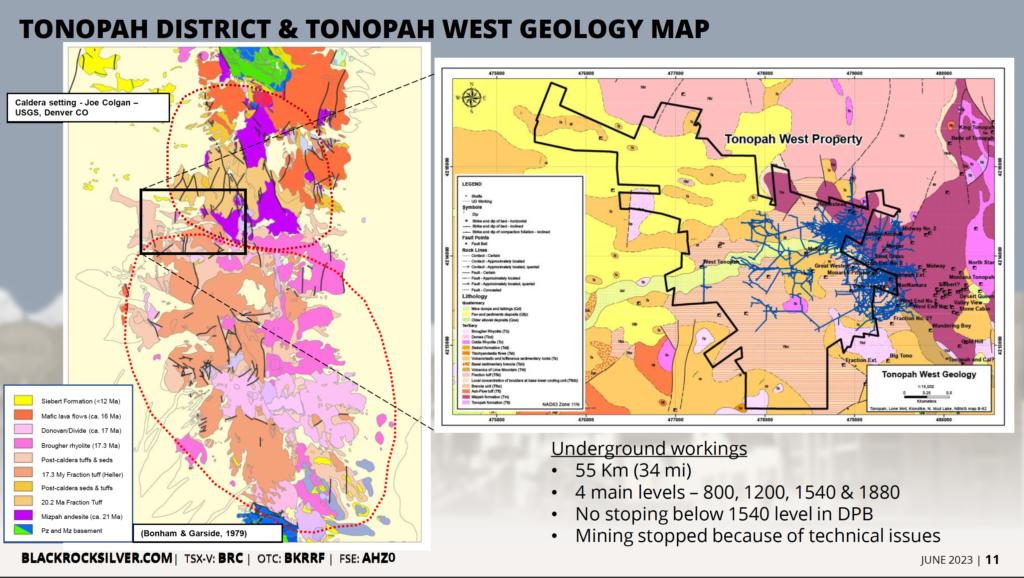
Historically, it produced 174 million oz. silver and 1.8 million oz, gold from 7.5 million tonnes.
The Tonopah District was mined underground from 1900 to 1930, with peak years producing up to 14 million oz. yearly of silver-equivalent.
According to Howald, mining ceased when the old timers met the water table, and pumping technologies were inadequate to deal with ingress. The project’s Victor vein was 24 metres thick, where production ceased and is likely where early mining would resume.
Today, the Tonopah project holds an NI 43-101-compliant underground inferred resource of 3 million tonnes grading 446 grams silver-equivalent per tonne for 42.7 million oz. (The silver-equivalent grade is based on silver and gold prices of US$20 per oz. and US$1,750 per oz., respectively, and recoveries for silver and gold of 87% and 95%, respectively.)
Most promising of last year’s work was hole TXC22-074, which cut 4.4 metres grading 2.36 grams gold and 162.5 grams silver per tonne (399.3 grams silver-equivalent), including 1.5 metres of 712 grams silver-equivalent (3.78 grams gold and 334 grams silver), suggesting a strongly mineralized northwest structure.
“We’re doing the drill-Hokey Pokey, where we take one big step out and then retrace our track to examine what lies in between,” Howald says. “We’re seeing a significant return on investment via the drill bit. We have an all-in discovery cost of US62¢ per oz. of silver equivalent.” (That cost includes exploration, project holding/option costs, and general and administrative costs.)

The Victor mine’s former headgear remains standing on the outskirts of Tonopah. Armed with modern pumping technology, Blackrock Silver is ready to resume mining the good stuff where the old timers left off. Credit: Henry Lazenby
With over 150,000 metres of drilling completed since June 2020, Tonopah West is billed as North America’s most active silver exploration project.
Significant intercepts range from 1 to 29 metres in thickness, with grades up to 6,526 grams silver-equivalent (up to 37 grams gold and 2,740 grams silver). The team has described 10 veins ranging from 425 metres up to 3 km in the drill-defined strike, and the deposit remains open to the northwest, south, and at depth.
Howald, who notes that Blackrock is the first group to conduct exploration targeting the historical workings and examining the many historic mines on the property, is optimistic about the knowledge base the company has been able to build to date.
He says Blackrock has used the time between drill programs to update and incorporate all 2022 drill information into its geologic model.
The new model includes Blackrock’s northwest step-out drilling, which is located one kilometre northwest of Tonopah West’s DPB resource and increases the strike length of the vein system to over three kilometres.
“Step-out drilling continues to expand the mineralized footprint well beyond the April resource boundary and remains open to the south, northwest, and at depth,” he says. He added that the project’s Denver vein system had also now been tracked an additional 1.6 kilometres just to the northwest beyond the DPB resource area.
The updated geological model will form the basis for an updated resource estimate in the second half of this year. Based on the geologic model, the northwest step-out area is projected to add tonnage at a similar grade.
In addition, the company is planning its next drill program, which will infill the northwestern step-out area to the main resources at the Victor and DPB zones.
East of Tonopah
Meanwhile, next door and directly east of Tonopah, Summa Silver, under the direction of CEO Galen McNamara, is undertaking a similar strategy at its Hughes project.
McNamara is hugely optimistic about the company’s prospects of discovering an eastern district extension.
“Covering five kilometres of its possible eastern extension, the Hughes property represents a unique opportunity to both revitalize a historical district and make discoveries in the shadows of the headframes of some of America’s great historic silver producers,” McNamara says.
The team has assembled a previously underexplored land package of 22.3 sq. km, and the company has just resumed drilling at its Ruby discovery of 2020 and 2021, representing the easternmost portion of the Tonopah District’s known strike length.
Drill highlights to date include hole SUM21-30, which cut 3,971 grams of silver-equivalent over 2.8 metres, hole SUM20-06, which returned 536 grams of silver-equivalent over 18.1 metres and SUM21-31 which intersected 1,529 grams silver-equivalent over 4.3 metres.
McNamara says the team has until now cut several zones with a grade higher than 1,000 grams silver-equivalent per tonne over a 3.5-km trend, with many priority targets untested.
The three holes drilled by the company at Ruby in 2020 and 2021 all intersected zones of quartz veining, alteration and intermittent mineralization with features strikingly similar to the orebodies in the heart of Tonopah district, McNamara says.
Subsequent 3-D induced-polarization geophysical survey work identified parallel chargeability and resistivity anomalies immediately along the strike to the east of the drilled area. The anomalies are interpreted to represent broad zones of sulphide-rich, quartz-dominant hydrothermal-related alteration.
The company’s modelling also suggests an east-west trend to the structural zone, which the company’s summer drilling will aim to confirm. Drilling will investigate the eastern strike extent of Ruby mineralization, and the exploration target is an extension of the Tonopah district.
New targets include Emerald, Diamond, Sapphire, and Topaz, all of which lie just outside the historic Tonopah mining district.
McNamara outlines this year’s drill plans involving two reverse circulation holes pre-collars, core tails through target zones, and four holes at other targets. A portable X-ray fluorescence instrument will provide real-time geochemical data on key pathfinder elements. Additional drilling may be conducted based on early results.
The company has about $9.5 million cash in the bank, which should be enough to see the company through to at least the following season.
From atop one of Tonopah’s most distinctive features – old mine dumps lining the hillside now known as Tonopah Historic Mining Park – one is surrounded by the rocks that tell Tonopah’s story. Given higher metal prices and the application of modern technologies, the region could be poised for a mining renaissance.

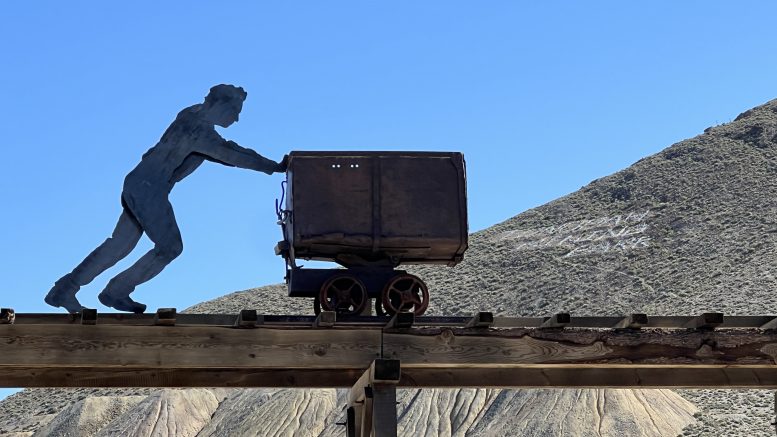
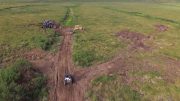
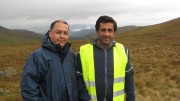

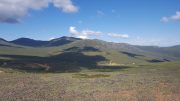
Be the first to comment on "Site visit: Tonopah primed for mining renaissance as precious metals attract prospectors"